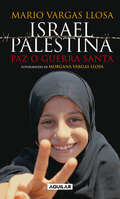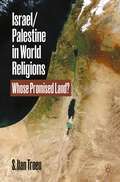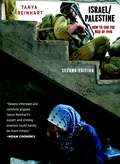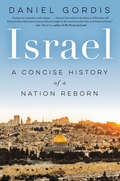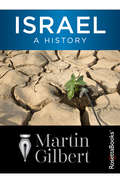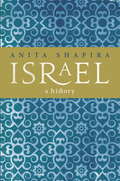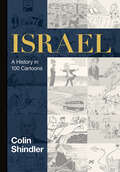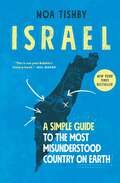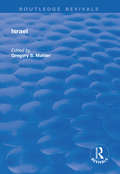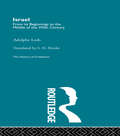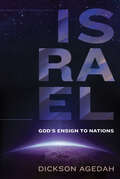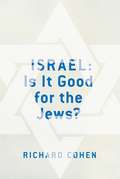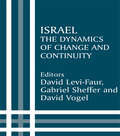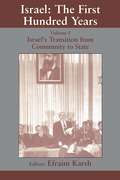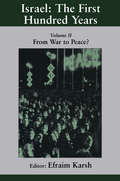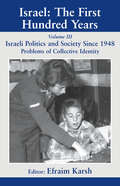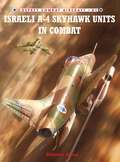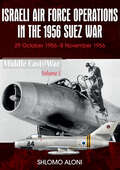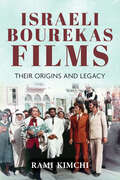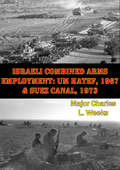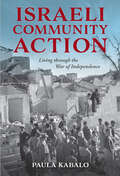- Table View
- List View
Israel/Palestina: Paz o Guerra Santa
by Mario Vargas LlosaEstas crónicas son el resultado de un viaje a Israel y Palestina que Mario Vargas Llosa realizó con su hija Morgana a raíz de la decisión de Ariel Sharon de desalojar los asentamientos de Gaza. «Estos textos fueron escritos en Israel, la franja de Gaza y los territorios ocupados de Cisjordania a mediados de 2005. Fui allí con mi hija Morgana para tratar de averiguar si la decisión unilateral de Ariel Sharon de desalojar los asentamientos de Gaza abría una nueva perspectiva de paz en la región y la manera como palestinos e israelíes reaccionaban antes esta iniciativa. Aunque el territorio es tan pequeño que un viajero puede circunvalarlo entre el desayuno y la cena, en la actualidad resulta complicado recorrerlo -a veces pesadillesco- por las barreras militares y el muro que lo cuadrillan y las colas, los controles y los interrogatorios que en cada uno de estos puntos demoran el tránsito. A pesar de ello, la experiencia resultó fascinante porque en ese rincón del mundo la historia parece más potente y la vida más intensa que en cualquier otro lugar. Las leyendas son fieles en espíritu a las informaciones recogidas de viva voz de boca de sus protagonistas, pero ellas resumen en unas frases lo que a veces fueron conversaciones de muchas horas, y, a veces, confesiones sueltas y monólogos desordenados. Mis textos omiten muchas cosas y recrean otras pero no creo haber tergiversado en ellos -no conscientemente en todo caso- nada esencial de lo que palestinos e israelíes me dijeron.» Mario Vargas Llosa
Israel/Palestine (3rd Edition)
by Alan DowtyIn this timely update of the 2008 and 2005 editions, Dowty (emeritus, political science, U. of Notre Dame) provides a balanced lens on the ongoing Israeli-Palestinian conflict from each side's historical and contemporary perspectives. He concludes that subjective causes have overtaken territorial claims as obstacles to peaceful resolution. The work includes maps of shifting borders, a chronology, further reading, and supporting tables and figures. Distributed by Wiley. Annotation ©2013 Book News, Inc. , Portland, OR (booknews. com)
Israel/Palestine in World Religions: Whose Promised Land?
by S. Ilan TroenThe struggle over Israel/Palestine is not just another contest by competing nationalisms or an instance of geopolitical competition. It is also about control of sacred territory that involves local Jews, Muslims, and Christians as well as worldwide faith communities, each with their own interests and stake in what transpires. This balanced introduction to a complex subject presents the multiple positions within the great monotheistic traditions. It demonstrates that the secular discourses in the public square concerning ownership privileges, historical precedence, political rights, and justice that have allegedly replaced religious claims actually coexist with, and often complement, the theological. It explores the century-long tangle of secular and theological debates about Israel’s legitimacy. Whether readers support a Jewish state or are resolutely opposed, the serious and substantial scholarship of this well-reasoned and innovative book will contribute to a nuanced and better-informed understanding of this persistent issue that has entered its second century on the international agenda.
Israel/Palestine: How to End the War of 1948 (Open Media Series)
by Tanya ReinhartIn Israel/Palestine, Reinhart traces the development of the Security Barrier and Israel's new doctrine of "disengagement," launched in response to a looming Palestinian-majority population. Examining the official record of recent diplomacy, including United States-brokered accords and talks at Camp David, Oslo, and Taba, Reinhart explores the fundamental power imbalances between the negotiating parties and identifies Israel's strategy of creating facts on the ground to define and complicate the terms of any future settlement. In this indispensable primer, Reinhart's searing insight illuminates the current conflict and suggests a path toward change.
Israel: A Concise History of a Nation Reborn
by Daniel GordisThe first comprehensive yet accessible history of the state of Israel from its inception to present day, from Daniel Gordis, "one of the most respected Israel analysts" (The Forward) living and writing in Jerusalem.Israel is a tiny state, and yet it has captured the world's attention, aroused its imagination, and lately, been the object of its opprobrium. Why does such a small country speak to so many global concerns? More pressingly: Why does Israel make the decisions it does? And what lies in its future?We cannot answer these questions until we understand Israel's people and the questions and conflicts, the hopes and desires, that have animated their conversations and actions. Though Israel's history is rife with conflict, these conflicts do not fully communicate the spirit of Israel and its people: they give short shrift to the dream that gave birth to the state, and to the vision for the Jewish people that was at its core. Guiding us through the milestones of Israeli history, Gordis relays the drama of the Jewish people's story and the creation of the state. Clear-eyed and erudite, he illustrates how Israel became a cultural, economic and military powerhouse--but also explains where Israel made grave mistakes and traces the long history of Israel's deepening isolation. With Israel, public intellectual Daniel Gordis offers us a brief but thorough account of the cultural, economic, and political history of this complex nation, from its beginnings to the present. Accessible, levelheaded, and rigorous, Israel sheds light on the Israel's past so we can understand its future. The result is a vivid portrait of a people, and a nation, reborn.
Israel: A History
by Martin Gilbert&“The most comprehensive account of Israeli history yet published&” (Efraim Karsh, The Sunday Telegraph). Fleeing persecution in Europe, thousands of Jewish immigrants settled in Palestine after World War II. Renowned historian Martin Gilbert crafts a riveting account of Israel&’s turbulent history, from the birth of the Zionist movement under Theodor Herzl to the unexpected declaration of its statehood in 1948, and through the many wars, conflicts, treaties, negotiations, and events that have shaped its past six decades—including the Six Day War, the Intifada, Suez, and the Yom Kippur War. Drawing on a wealth of first-hand source materials, eyewitness accounts, and his own personal and intimate knowledge of the country, Gilbert weaves a complex narrative that&’s both gripping and informative, and probes both the ideals and realities of modern statehood. &“Martin Gilbert has left us in his debt, not only for a superlative history of Israel, but also for a restatement of the classic vision of Zion, in which a Middle East without guns is not a bedtime story but an imperative long overdue. This is the vision for which Yitzhak Rabin gave his life. This book is tribute to his memory.&” —Jonathan Sacks, The Times (London)
Israel: A History (The\schusterman Series In Israel Studies)
by Professor Anita ShapiraA timely and definitive narrative history of Israel in the context of the modern Jewish experience and the Middle East. Ideal for anyone seeking to understand the roots of the current conflict in Gaza.Written by one of Israel's most notable scholars, this volume provides a breathtaking history of Israel from the origins of the Zionist movement in the late 19th century to the present day.Anita Shapira's gripping narrative explores the emergence of Zionism in Europe against the backdrop of relations among Jews, Arabs and Turks, and the earliest pioneer settlements in Palestine under Ottoman rule. Weaving together political, social and cultural developments in Palestine under the British mandate, Shapira creates a tapestry through which to understand the challenges of Israeli nation-building, including mass immigration, shifting cultural norms, the politics of war and world diplomacy, and the creation of democratic institutions and a civil society. References to contemporary diaries, memoirs and literature bring a human dimension to the story of Israel, from its declaration of independence in 1948 through successive decades of waging war, negotiating peace, and building a modern state with a vibrant society and culture.Based on archival sources and the most up-to-date scholarly research, this authoritative history is a must-read for anyone with a passionate interest in Israel and the Middle East. ISRAEL: A HISTORY will be the gold standard in the field for years to come.
Israel: A History in 100 Cartoons
by Colin ShindlerSince its establishment in 1948, the state of Israel has not ceased to be a unique and controversial entity: vehemently opposed by some, and loyally supported by others. In this novel and original study, Colin Shindler tells the history of Israel through the unusual vehicle of cartoons - all drawn by different generations of irreverent and contrarian Israeli cartoonists. Richly illustrated with a cartoon for every year since Israel's establishment until 2020, Shindler offers new perspectives on Israel's past, politics, and people. At once incisive and hilarious, these cartoons, mainly published in the Israeli press, capture significant flashpoints, and show how the country's citizens felt about and responded to major events in Israel's history. A leading authority on Israel Studies, Shindler contextualises the cartoons with detailed timelines and commentaries for every year. Sometimes funny and sometimes tinged with tragedy, Shindler offers a new, visually exciting, and accessible way to understand Israel's complex history and, in particular, the Israel-Palestine conflict.
Israel: A Simple Guide to the Most Misunderstood Country on Earth
by Noa TishbyA NEW YORK TIMES BESTSELLER A &“fascinating and very moving&” (Aaron Sorkin, award-winning screenwriter of The West Wing and The Social Network) chronological timeline spanning from Biblical times to today that explores one of the most interesting countries in the world—Israel.Israel. The small strip of arid land is 5,700 miles away but remains a hot-button issue and a thorny topic of debate. But while everyone seems to have a strong opinion about Israel, how many people actually know the facts? Here to fill in the information gap is Israeli American Noa Tishby. But &“this is not your Bubbie&’s history book&” (Bill Maher, host of Real Time with Bill Maher). Instead, offering a fresh, 360-degree view, Tishby brings her &“passion, humor, and deep intimacy&” (Yossi Klein Halevi, New York Times bestselling author of Letters to My Palestinian Neighbor) to the subject, creating an accessible and dynamic portrait of a tiny country of outsized relevance. Through bite-sized chunks of history and deeply personal stories, Tishby chronicles her homeland&’s evolution, beginning in Biblical times and moving forward to cover everything from WWI to Israel&’s creation to the disputes dividing the country today. Tackling popular misconceptions with an abundance of facts, Tishby provides critical context around headline-generating controversies and offers a clear, intimate account of the richly cultured country of Israel.
Israel: An Introduction
by Barry RubinThis comprehensive book provides a well-rounded introduction to Israel—a definitive account of the nation's past, its often controversial present, and much more. Written by a leading historian of the Middle East,Israelis organized around six major themes: land and people, history, society, politics, economics, and culture. The only available volume to offer such a complete account, this book is written for general readers and students who may have little background knowledge of this nation or its rich culture. Based on research by scholars with extensive firsthand knowledge of Israel, this book offers accessible, clearly explained material, enhanced with a generous selection of images, maps, charts, tables, graphs, and sidebars. This book provides readers with a solid foundation of knowledge about Israel and provides useful reference lists by topic for those inspired to read further.
Israel: Development And Conflict (The\international Library Of Politics And Comparative Government)
by Gregory S. MahlerThis title was first published in 2000: The International Library of Politics and Comparative Government brings together in one series, the most significant journal articles to appear in the field of comparative politics in the last twenty-five years. It makes accessible to teachers, researchers and students an extensive range of essays which provide an indispensable basis for understanding both the established conceptual terrain and the new ground being broken in the fast changing field of comparative political analysis. A number of acknowledged experts have been invited to act as editors for the series. They preface each volume with an introductory essay in which they review the basis for the selection of articles and suggest future directions of research and investigation in the subject area. An invaluable resource for all those working in the field of comparative government and politics.
Israel: From Its Beginnings To The Middle Of The Eighth Century (The\history Of Civilization Ser. #Vol. 6013833)
by Adolphe LodsOriginally published between 1920-70,The History of Civilization was a landmark in early twentieth century publishing. It was published at a formative time within the social sciences, and during a period of decisive historical discovery. The aim of the general editor, C.K. Ogden, was to summarize the most up-to-date findings and theories of historians, anthropologists, archaeologists and sociologists. This reprinted material is available as a set or in the following groupings, or as individual volumes: * Prehistory and Historical Ethnography Set of 12: 0-415-15611-4: £800.00 * Greek Civilization Set of 7: 0-415-15612-2: £450.00 * Roman Civilization Set of 6: 0-415-15613-0: £400.00 * Eastern Civilizations Set of 10: 0-415-15614-9: £650.00 * Judaeo-Christian Civilization Set of 4: 0-415-15615-7: £250.00 * European Civilization Set of 11: 0-415-15616-5: £700.00
Israel: God's Ensign to Nations
by Dickson AgedahWhy has such a small nation and its people--Israel and the Jews--been the target of so much hatred, for so long? Today's alarming headlines from the Middle East, and tomorrow's trajectory for the region, cannot truly be understood without knowing its complicated history. Israel has been planted as a flag, pointing the world to God. Weaving together biblical and human records, Dickson Agedah brings fresh light on the religious, political, and military roots of the ongoing unrest centered on the land of Jesus' birth. Behind the enmity to the Jewish people and their homeland, he explains, is an all-out spiritual effort to thwart God's plan for the world. A review of Israel’s tortuous and turbulent history reveals and verifies the covenant that God has with His people--an immutable promise extending to all peoples. And while sobering and surprising, this study offers an inspiring message of hope in the sure fulfillment of God's eternal victory and restoration.
Israel: Is It Good For The Jews?
by Richard M. CohenA very personal journey through Jewish history (and Richard Cohen&’s own), and a passionate defense of Israel&’s legitimacy.Richard Cohen&’s book is part reportage, part memoir—an intimate journey through the history of Europe&’s Jews, culminating in the establishment of Israel. A veteran, syndicated columnist for The Washington Post, Cohen began this journey as a skeptic, wondering in a national column whether the creation of a Jewish State was &“a mistake.&” As he recounts, he delved into his own and Jewish history and fell in love with the story of the Jews and Israel, a twice-promised land—in the Bible by God, and by the world to the remnants of Europe&’s Jews. This promise, he writes, was made in atonement not just for the Holocaust, but for the callous indifference that preceded World War II and followed it—and that still threatens. Cohen&’s account is full of stories—from the nineteenth century figures who imagined a Zionist country, including Theodore Herzl, who thought it might resemble Vienna with its cafes and music; to what happened in twentieth century Poland to his own relatives; and to stories of his American boyhood. Cohen describes his relationship with Israel as a sort of marriage: one does not always get along but one is faithful.
Israel: The Dynamics of Change and Continuity (Israeli History, Politics and Society #4530)
by David Vogel Gabriel Sheffer David Levi-FaurThese essays examine changes in Israel's political, social and economic institutions, and describe how Israeli culture and institutions are resisting convergence. They are in four categories: political institutions and organizations; political economy; ethnicity and religion; and public policy.
Israel: Volume I: Israel’s Transition from Community to State (Israeli History, Politics and Society #Vol. 2)
by Efraim KarshThe Zionist Movement was born in the wake of Jewish emancipation in Western Europe, and at a time of increased persecution in Eastern Europe. This volume addresses the intellectual, social and political ramifications of Jewish settlement in Eretz Israel before the creation of the State of Israel.
Israel: Volume II: From War to Peace? (Israeli History, Politics and Society #Vol. 2)
by Efraim KarshThe end of the British mandate in Palestine heralded the birth of the new state of Israel. It also marked the end of one of the most tumultuous and momentous chapters in Israeli history. But the new state, born into a hostile environment and struggling with the manifold demands of sovereignty, would have to face many post-Independence challenges to its existence, not least in the form of armed conflict and confrontation with its Arab neighbours. This volume examines the conflicts that from the 1948 until the 1967 Six Day War came to define the Israeli struggle for existence.
Israel: Volume III: Politics and Society since 1948 (Israeli History, Politics and Society #Vol. 2)
by Efraim KarshSince its founding in 1948 Israel has faced many political, social and psychological challenges, unfamiliar to other nations on the western democratic political model and peculiar to the Jewish state. This work covers the role of politics in Israel since 1948.
Israel: Years of Challenge
by David Ben-GurionThe history of the Jewish homeland by the personification of Israel's robust and resolute spirit.
Israeli A-4 Skyhawk Units in Combat
by Jim Laurier Shlomo AloniThe light and agile A-4 Skyhawk was the first modern American jet to be offered to the Israeli Air Force, marking the point where the US took over from France as Israel's chief military supplier. Deliveries began too late for the A-4 to fight in the Six-Day War (1967), but it soon formed the backbone of the IAF's ground-attack force. From 1969 to 1970 it flew endless sorties against Egyptian forces in the War of Attrition (1967-1970). Then, during the Yom Kippur War (1973), five squadrons of A-4s saw combat and 50 planes were lost as they battled against the Arab armored onslaught. Using previously unpublished first-hand accounts and rare photography from the IAF archives and pilots' private collections, Shlomo Aloni tells the definitive history of the IAF's A-4 squadrons, including the story of Ezra "BABAN" Dotan who became an ace with an unique double-kill of MiG17s.
Israeli Air Force Operations in the 1948 War: Israeli Winter Offensive Operation Horev 22 December 1948–7 January 1949 (Middle East at War #2)
by Shlomo AloniOperation HOREV – the Israeli winter offensive from December 1948 until January 1949 – practically ended Israel’s War for Independence (also known as the 1948 Arab-Israeli War), with an Israeli victory that forced Egypt to seek ceasefire and to negotiate a settlement with the fledgling nation. From HOREV Day 1 on 23 December 1948 until HOREV Day 16 on 7 January 1949, this title presents Israeli Air Force missions during Operation HOREV in heretofore unseen depth and detail. This title chronicles Israeli Air Force sorties during Operation HOREV; from Austers and Pipers to C-46s and C-47s; from Messerschmitts, Spitfires and P-51s to Beaufighters and B-17s; Israel Air Force operations are detailed spanning the timeline of the conflict down to every unearthed sortie in depth, and shown in a way that Israeli Air Force operations during Operation HOREV had never been presented before. This level of detail has been made possible by extensive use of contemporary documentation. The detailed text is supported by numerous photographs and color profiles. Middle East@War - following on from our highly successful Africa@War series, Middle East@War replicates the same format - concise, incisive text, rare images and high quality color artwork providing fresh accounts of both well-known and more esoteric aspects of conflict in this part of the world since 1945.
Israeli Air Force Operations in the 1956 Suez War: 29 October–8 November 1956 (Middle East at War #3)
by Shlomo AloniBy participating in 1956 Suez Crisis Israel exploited an opportunity to join forces with France and the United Kingdom in an attack against Egypt in order to accomplish diplomatic, military and political objectives: to open the Red Sea international shipping lane to ships sailing from and to Eilat; to strengthen its alliance with France; to end – or at least to scale down – Egyptian hosted Palestinian terror attacks against Israel; to launch a preventive war in order to crush Egyptian military power before its completion of the transition to Soviet weapons could tempt Egypt to attack Israel and in order to accomplish a profound victory to deter Egypt from pursuing a another round of war policy. Operation KADESH was the Israeli part in the Anglo-French attack and this title chronicles Israeli Air Force operations along the timeline of Operation KADESH – from day 1 on 29 October 1956 until day 11 on 8 November 1956 – in thus far unmatched depth and detail; all known Israel Air Force missions and sorties are listed and described and all air combats between Israeli Mysteres and Egyptian MiGs and Vampires are presented and analyzed. The large variety of aircraft flown – Dassault Mysteres, Dassault Ouragans and Gloster Meteors; B-17 Flying Fortresses, P-51 Mustangs and De Havilland Mosquitoes; T-6 Texans (Harvards) and T-17 Kaydets (Stearmans); Nord 2501 Noratlases, C-47 Skytrains (Dakotas), Pipers and Consuls and even a pair of Sikorsky S-55 helicopters – are all covered in this title, which presents Israeli Air Force operations during the Suez War in a depth and detail unseen in previous publications. The text is supported by numerous photographs and color profiles. Middle East@War - following on from our highly successful Africa@War series, Middle East@War replicates the same format - concise, incisive text, rare images and high quality color artwork providing fresh accounts of both well-known and more esoteric aspects of conflict in this part of the world since 1945.
Israeli Bourekas Films: Their Origins and Legacy (Sephardi and Mizrahi Studies)
by Rami KimchiA genre of comic melodramas produced in the 1960s and '70s, Bourekas films are among the most popular films ever made in Israel. In Israeli Bourekas Films, author and filmmaker Rami Kimchi sets out a history of Bourekas films and discusses their origin.Kimchi considers the representation of Sephardi or Mizrahi Jews in the films, noting that the material culture reflected in the the films presented a culture that was closer to the European Yiddish culture than to the Middle Eastern world of the Mizrahim. Kimchi reflects on the enormous popularity and commercial success of Bourekas films, uncovers how they were made, who made them and why, and discusses the impact of the films on Israeli cinema today. Israeli Bourekas Films is a film insider's view of the characters, stories, and cultures that made Bourekas films such an important part of Israeli life.
Israeli Combined Arms Employment: Um Katef, 1967 & Suez Canal, 1973
by Major Charles L. WeeksThe next desert war the United States fights could be against an enemy more comparable to us in training, motivation, and technology than the recent conflict in the Persian Gulf. The Middle East is a dangerous part of the world where we have limited experience in the use of high technology weapons, or in large-scale combat even given the recent war against Iraq. Since we have limited experience in these areas, this thesis analyzes two of the most recent historical examples of such combat from the 1967 and 1973 Arab-Israeli Wars to reveal conclusions useful to U. S. war fighters.This thesis examines the Battle of Um Katef, Abu Ageila from the 1967 War, and the Sinai Campaign from the 1973 War. They were examined primarily from secondary sources, using the U. S. Army battlefield operating systems, as the framework to evaluate success or failure. The resulting keys to success or reasons for failure were then further evaluated against the four tenets of U. S. Airland Battle Doctrine (Agility, Initiative, Depth, and Synchronization).The result of this investigation is a number of conclusions regarding modern combined arms combat. These conclusions are categorized as strengths or weaknesses and presented as lessons learned. Surprisingly enough, none of the lessons learned proved to be environment specific.
Israeli Community Action: Living through the War of Independence (Perspectives on Israel Studies)
by Paula KabaloWhen the 1948 Israeli War of Independence broke out, population centers were rocked by sniper fire, bombings, and roadside ambushes. As the fighting moved out of the cities into desert areas, private citizens and community organizations left behind organized to revitalize and restore life in their devastated communities. In Israeli Community Action, Paula Kabalo presents a vivid portrait of these civilians who strove to help each other cope with the realities of war. Kabalo explores how civilian militias were recruited, how neighborhoods were protected, how older populations were enlisted into the war effort, and how women were organized to provide medical aid or establish refugee centers. She demonstrates that each phase of the war brought along new challenges to the population of the young state of Israel, but she also illuminates how the engagement of Israelis in community efforts brought them together and shored them up to face the future in their new country.
